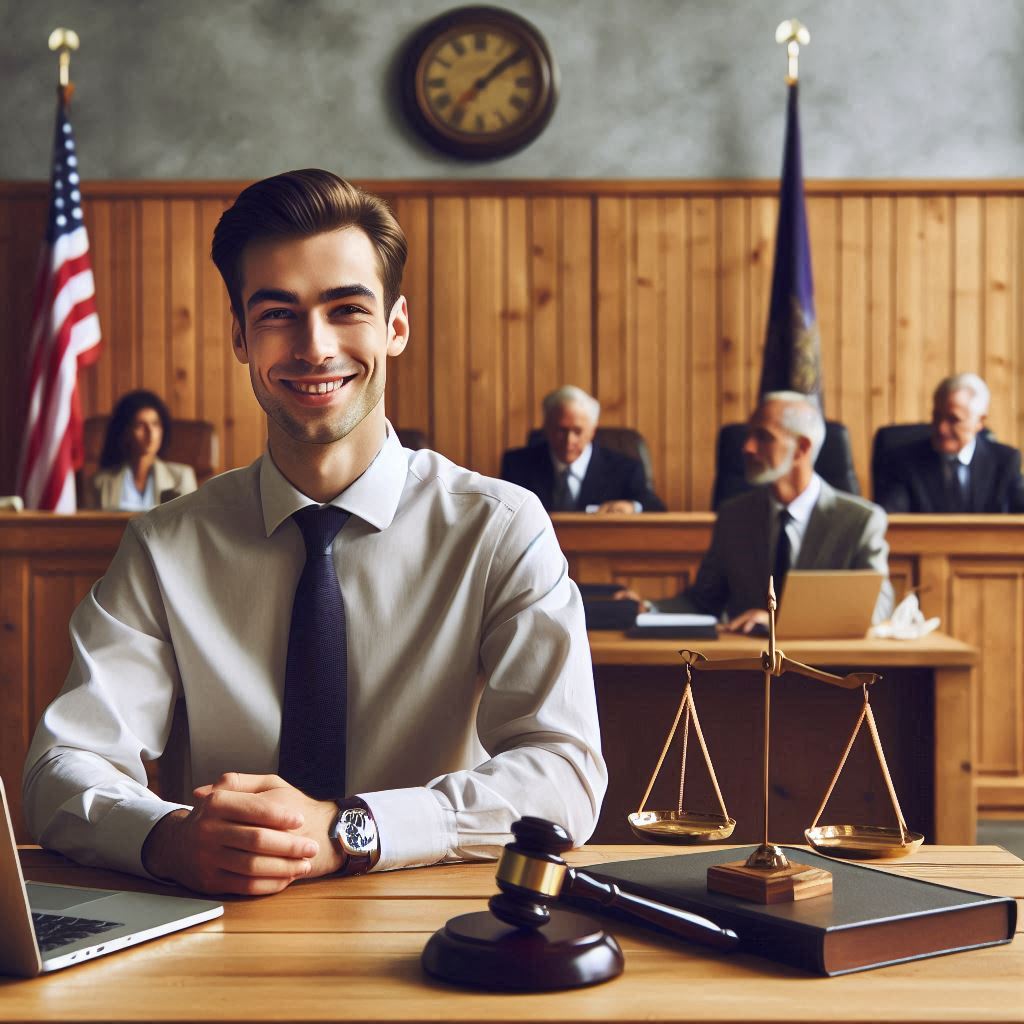Introduction
Body language plays a crucial role in jury selection. It offers insights into a potential juror’s true feelings and biases.
Jurors may not always articulate their beliefs openly. However, their body language often reveals more than their words.
During jury selection, attorneys carefully observe jurors’ non-verbal cues. These cues can indicate discomfort, agreement, or neutrality.
Understanding these signals helps attorneys gauge which jurors may be favorable or unfavorable to their case.
In this blog post, we will explore how body language influences jury selection. We will discuss key non-verbal signals to watch for.
Additionally, we will explain how attorneys interpret these signals to make strategic decisions.
We will also cover techniques for evaluating body language effectively.
Insights into how attorneys use these observations to shape their jury selections will be shared.
By the end, you will understand why body language is an essential tool in the jury selection process.
Effective jury selection hinges on reading beyond verbal responses. Observing body language helps attorneys identify jurors who may be biased or impartial.
This process ultimately impacts the outcome of a trial.
Stay tuned as we delve deeper into the vital role body language plays in shaping jury selection strategies.
Understanding the basics of body language
Body language and its significance in communication
Body language encompasses all nonverbal signals that we use to communicate with others.
These signals can include facial expressions, hand gestures, body posture, eye contact, and even the tone of our voice.
While verbal communication is important, studies have shown that a significant portion of our interactions is actually nonverbal.
In fact, some experts argue that up to 55% of communication is conveyed through body language, while only 7% is attributed to spoken words.
Understanding body language is essential in deciphering hidden messages and cues that may not be articulated verbally.
It can provide valuable insights into a person’s true feelings, emotions, and intentions, offering a deeper understanding of their underlying thoughts.
How body language can convey emotion and intent
One of the key functions of body language is its ability to convey emotions and intentions.
Facial expressions, for example, can reveal a person’s feelings of happiness, sadness, anger, or fear.
Transform Your Career Today
Unlock a personalized career strategy that drives real results. Get tailored advice and a roadmap designed just for you.
Start NowPosture and body movements can indicate whether someone is confident or nervous, open and receptive, or closed off and defensive.
Eye contact can demonstrate interest, honesty, or avoidance, depending on the context.
By paying attention to these nonverbal cues, we can gauge a person’s level of engagement, truthfulness, and credibility.
This is particularly crucial in settings like jury selection, where assessing a potential juror’s demeanor and disposition can impact the outcome of a trial.
Different types of body language cues to look out for in jury selection
When selecting jurors, lawyers and trial consultants often rely on body language cues to assess a potential juror’s suitability for the case.
Some common types of nonverbal signals to watch for include:
- Facial expressions: Smiling, frowning, furrowing brows, or rolling eyes can indicate a person’s feelings towards the case.
- Posture: Leaning forward can signal interest, while crossing arms may suggest defensiveness or disagreement.
- Eye contact: Maintaining direct eye contact can signify attentiveness and engagement, while avoiding eye contact may indicate discomfort or deception.
- Gestures: Hand movements or fidgeting can reveal nervousness, agitation, or impatience.
- Tone of voice: Variation in tone, pitch, and volume can express emotions such as anger, excitement, or uncertainty.
- Microexpressions: Brief facial expressions that flash across a person’s face can reveal concealed emotions or reactions.
By observing these body language cues during jury selection, legal professionals can gain valuable insights into a juror’s biases, attitudes, and potential influence on the case.
This nuanced understanding can help attorneys make informed decisions about selecting the most impartial and competent jurors for trial.
In essence, body language is a powerful tool in communication, conveying emotions, intentions, and attitudes that may not be explicitly stated.
Understanding the basics of body language and recognizing its significance in jury selection can significantly impact the outcome of a trial by providing valuable insights into a potential juror’s mindset and suitability for the case.
Read: Civil Rights Advocacy: Legal Resources and Tools
Building trust and rapport with potential jurors
How body language can help establish trust and rapport with jurors
When it comes to jury selection, building trust and rapport with potential jurors is crucial.
Body language plays a significant role in establishing trust and rapport with jurors.
Tips on how to use body language effectively to create a positive impression
- By using open and welcoming body language, attorneys can create a positive impression.
- Make eye contact, smile genuinely, and maintain an open posture to convey warmth.
- Avoid crossing your arms, frowning, or displaying closed-off body language during jury selection.
- Leaning in slightly and nodding at appropriate times can show jurors that you are engaged.
- Mirroring the jurors’ body language subtly can help create a sense of connection.
- Remember that jurors are assessing you not only based on what you say but also how you present yourself.
Impact of body language on building credibility with jurors
Building credibility with jurors is essential for persuading them to trust your arguments.
Being mindful of your body language can make a significant impact on how jurors perceive you.
Practice active listening by nodding, making eye contact, and responding appropriately to jurors’ responses.
Show genuine interest in what potential jurors have to say by maintaining good eye contact.
Avoid distractions and focus entirely on the jurors during the jury selection process.
Demonstrate respect for potential jurors by giving them your full attention and showing appreciation for their time.
Showcase Your Business Today
Reach thousands of readers actively exploring professional services. Publish your business profile and grow your audience now.
Publish NowUtilize positive body language to convey sincerity, honesty, and empathy during jury selection.
Remember that jurors are more likely to trust and believe someone who appears authentic and genuine.
Pay attention to nonverbal cues from potential jurors to gauge their reactions and adjust your approach accordingly.
Practice good posture, maintain eye contact, and use open gestures to establish credibility with jurors.
Building trust and rapport with potential jurors through positive body language can enhance your chances of selecting the right jury for your case.
Read: Common Misconceptions About Jury Consultants
Identifying deceptive body language cues
Body language can reveal much about a person’s true feelings and intentions. During jury selection, identifying deceptive cues is crucial.
Certain body language signals often indicate that a juror may not be truthful. Understanding these signs can help in selecting the most reliable jury members.
How certain body language cues can indicate deception
Deceptive body language often includes inconsistent verbal and non-verbal cues.
For example, a person might say one thing but show non-verbal signs of discomfort.
Common deceptive cues include avoiding eye contact, fidgeting, and sudden changes in posture.
These behaviors can suggest that a juror is hiding something or is not being fully honest.
Examples of common deceptive body language cues to watch for during jury selection
During jury selection, watch for specific deceptive cues. A juror who frequently looks away or avoids eye contact may be hiding their true feelings.
Fidgeting with objects, such as pens or jewelry, can indicate nervousness or discomfort. Crossed arms or a closed posture often signal defensiveness or resistance.
Additionally, inconsistencies between what is said and the body language displayed can be a strong indicator of deception.
Importance of being able to discern between genuine and deceptive body language
Discernment between genuine and deceptive body language is essential for effective jury selection.
Misinterpreting a juror’s body language can lead to selecting individuals who may not provide fair assessments.
Accurate identification of deceptive cues ensures that the jury is composed of members who are honest and impartial.
This improves the overall fairness and integrity of the legal process. By honing skills to detect deception, attorneys can better ensure a fair trial outcome.
Read: Effective Communication for Civil Rights Lawyers

Reading nonverbal cues during questioning
Role of body language in interpreting nonverbal cues during jury questioning
Body language plays a crucial role in jury questioning. Jurors’ nonverbal cues can reveal their true feelings and biases.
For instance, crossed arms may indicate defensiveness or discomfort. Leaning forward often shows engagement or interest.
Observing these cues helps attorneys gauge jurors’ reactions and underlying thoughts.
Strategies for observing and interpreting jurors’ body language during questioning
To effectively observe and interpret jurors’ body language, attorneys should focus on several strategies.
First, watch for consistent patterns across multiple jurors. Single instances might be misleading, but recurring behaviors offer valuable insights.
Pay attention to facial expressions, posture, and eye contact. Note any sudden changes in body language, which might signal discomfort or dishonesty.
Additionally, compare jurors’ body language with their verbal responses. Discrepancies between what jurors say and how they behave can be telling.
For example, a juror might verbally agree but show signs of confusion or disagreement through their body language.
Document these observations for later analysis and strategy adjustments.
How body language can help attorneys assess jurors’ credibility and honesty
Body language provides key indicators of a juror’s credibility and honesty.
Genuine interest often correlates with consistent and open body language, while nervous or evasive gestures might suggest dishonesty.
For example, avoiding eye contact or fidgeting could indicate a lack of truthfulness.
By carefully assessing these nonverbal cues, attorneys can make informed decisions about juror selection.
Understanding the nuances of body language helps attorneys anticipate potential biases and adjust their arguments accordingly.
This insight is vital for building a trustworthy and unbiased jury.
Read: Impact of Jury Consultants on Trial Outcomes
Adapting Body Language to Different Jurors
When it comes to jury selection, one of the key aspects to consider is adapting your body language to connect with jurors of different backgrounds and personalities.
Each juror is unique, and being able to adjust your body language accordingly can significantly impact how they perceive you and your case.
Importance of Adapting Body Language
- Establishing rapport: By adapting your body language to match that of the juror, you can establish a sense of rapport and connection.
- Building trust: Jurors are more likely to trust and believe someone who they feel is similar to them in terms of body language.
- Enhancing communication: Adjusting your body language can help improve communication with jurors who may have different preferences and communication styles.
Tips for Adjusting Body Language
- Observe and mirror: Take note of the juror’s body language cues and subtly mirror or match their gestures and posture.
- Adapt your tone: Match the tone and energy level of the juror to create a more harmonious interaction.
- Eye contact: Make appropriate eye contact based on the juror’s comfort level, avoiding prolonged or intense stares.
- Gesture naturally: Use gestures that feel natural and authentic to you, while also being in tune with the juror’s body language.
- Respect personal space: Be mindful of the juror’s personal space and adjust your proximity accordingly to ensure comfort.
Mirroring and Matching
Mirroring and matching refer to the practice of subtly imitating the body language of the person you are interacting with.
This can help build rapport and establish a connection that goes beyond verbal communication.
Showcase Your Business Today
Reach thousands of readers actively exploring professional services. Publish your business profile and grow your audience now.
Publish Now- Reflecting gestures: If a juror leans forward or crosses their arms, you can subtly mirror these movements to create a sense of rapport.
- Matching posture: Adjust your posture to match that of the juror, whether they are sitting back relaxed or leaning in attentively.
- Emulating energy levels: If a juror is speaking energetically, match their energy level to show engagement and interest in what they have to say.
- Listening attentively: Show that you are actively listening by mirroring the juror’s body language cues, such as nodding or mirroring their facial expressions.
- Adapting to cues: Pay attention to subtle cues like facial expressions, hand movements, and overall body language to adapt your own nonverbal communication accordingly.
Overall, adapting your body language to suit the preferences and communication styles of individual jurors is a valuable skill in jury selection.
By establishing rapport, building trust, and enhancing communication, you can significantly impact how jurors perceive you and your case, ultimately influencing their decisions.
Mastering the art of adjusting body language to connect with jurors of different backgrounds and personalities is essential for lawyers and legal professionals.
By observing, mirroring, and matching body language cues, you can build rapport, establish trust, and enhance communication with jurors, ultimately increasing the likelihood of a favorable outcome in your case.
Enhancing Persuasive Communication Through Body Language
Body language plays a crucial role in persuasive communication, especially during jury selection.
It can significantly impact how jurors perceive and make decisions in a trial.
In this section, we will explore how body language can be utilized to enhance persuasive communication during the jury selection process.
Impact of Confident Body Language
Confident body language can have a powerful influence on jurors’ perceptions.
When an attorney exudes confidence through their posture, gestures, and facial expressions, it can convey competence and credibility.
Jurors are more likely to trust and be swayed by an attorney who appears confident and in control.
Moreover, confident body language can help attorneys establish rapport with jurors.
By maintaining open and relaxed body language, attorneys can create a sense of connection and trust with the jury.
This can be particularly effective in building a positive relationship with jurors and increasing the likelihood of persuading them during jury selection.
Effective Body Language Strategies
Here are some effective body language strategies that attorneys can employ to persuade jurors during jury selection:
- Maintain eye contact: Making direct eye contact with jurors can convey sincerity and engagement.
It shows that the attorney is attentive and respectful, which can help build trust with the jury. - Use gestures strategically: Gestures can enhance verbal communication and make key points more memorable.
Attorneys should use gestures that are natural and purposeful, avoiding excessive or distracting movements. - Adopt an open posture: A relaxed and open posture signals approachability and confidence.
Attorneys should avoid crossing their arms or legs, as this can convey defensiveness or detachment. - Mirror jurors’ body language: Mirroring can establish rapport and create a sense of connection with jurors.
Attorneys should subtly match the posture and gestures of jurors to build a sense of unity and understanding. - Smile genuinely: A warm and genuine smile can help attorneys appear friendly and likable.
Smiling can also convey positivity and empathy, which can be instrumental in persuading jurors to align with the attorney’s arguments.
In a nutshell, body language plays a vital role in enhancing persuasive communication during jury selection.
By leveraging confident and strategic body language techniques, attorneys can influence jurors’ perceptions and decisions effectively.
Through mindful use of body language, attorneys can maximize their persuasive impact and increase their chances of success in the courtroom.
Conclusion
The importance of body language in jury selection cannot be overstated.
Body language can reveal crucial information about a potential juror’s thoughts, feelings, and biases that may not be expressed verbally.
By paying attention to body language cues, attorneys and litigators can make more informed decisions when selecting jurors, ultimately leading to a fairer and more impartial trial.
It is essential for readers to understand the role of body language in effectively communicating and connecting with jurors.
Building rapport and trust with jurors through nonverbal cues can significantly impact the outcome of a trial.
Therefore, it is crucial to be mindful of both the verbal and nonverbal messages conveyed during jury selection.
[E-Books for Sale]
The Big Book of 500 High-Paying Jobs in America: Unlock Your Earning Potential
$19.99 • 500 High-Paying Jobs • 330 pages
Explore 500 high-paying jobs in America and learn how to boost your career, earn more, and achieve success!
See All 500 High-Paying Jobs of this E-Book
1001 Professions Without a Degree: High-Paying American Jobs You Can Start Now
$19.99 • 1001 Professions Without a Degree • 174 pages
Discover 1001 high-paying jobs without a degree! Unlock career tips, skills, and success strategies for just $19.99!




